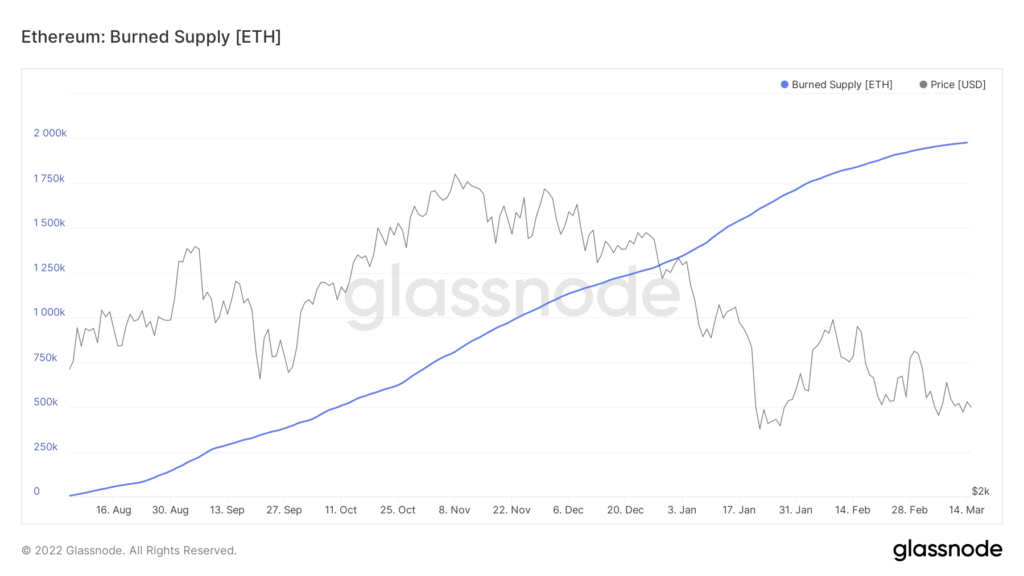Ethereum is approaching its most significant network upgrade in years—moving to proof of stake (PoS) from proof of work (PoS).
With the ‘merge’ potentially coming in the next few months, I explain why I think this is bullish for ETH, how less supply will enter the market and why a supply shock may not be entirely priced in by the market.
Quick rehash PoW vs PoS
Essentially PoW is powered by miners who use their excess computing power to solve equations, earning ETH in return.
PoS does not require traditional miners. Instead, it requires these validators to stake a certain amount of the blockchain’s native cryptocurrency (ETH in this case) to earn the right to provide consensus and verify transactions on the network.
Why there could be an ETH supply shock
The merge could trigger a supply shock in the market for ETH as it will reduce the amount of ETH issued anywhere from 70-90%. With ETH inflation set to drop from 4.3% to as low as 0.4%.
Combined with other factors such as burning, demand triggers, increased staking and locking of ETH, it could see a lot less ETH available in public markets to buy.
I think this is ultimately bullish for ETH.
Impact of PoS on issuance
Current (pre-merge)
Under PoW, Ethereum’s network issuance is approximately 4.5%. This is about 13.5K ETH a day or 5.5M in the year. Many miners also have to quickly sell their ETH to pay for mining costs.
Future (post-merge)
ETH issued will change with PoS. With a switch to PoS, Vitalik’s estimates the amount of ETH issued could decline significantly to around 500K–1M a year, anywhere from a 75-90% decrease in overall issuance compared to current figures. I discussed this in a previous post exploring ETH reducing issuance.
This is a considerable drop—effectively reducing issuance from >5M ETH to 0.5M ETH and reducing yearly inflation from ~4.3% to ~0.4%.
Including impacts of continued ETH burning, the ETH supply could decrease by 2.3% yearly.
*Keep in mind these figures will ultimately depend on things like gas prices, network fees, ETH burning, usage etc.
Combination with other factors
A supply shock could also be compounded with other catalysts.
ETH burned
The impact of EIP 1559 was more significant than expected. ETH burn is increasing at a rate of 66%, with ~2M ETH burned since EIP 1559. (READ: A Guide to EIP 1559).

Staked ETH
Yesterday, ETH hit 10M staked. A substantial amount of ETH is unavailable to be sold (almost 9% of the supply).
Once withdrawals are live, there is a legitimate worry that it could create substantial sell-side pressure through harvesting yield and taking any profits. Although I see a lot of users choosing to keep their ETH staked medium term.
This worry isn’t immediately relevant as withdrawals could be delayed by ~6 months following the merge.
Increasing ETH yield post-merge
The current yield ranges from 3–5%. After the merge, this could increase to 10%—depending on the total amount of stakers and non-burned transaction fees. (EDIT 22/04): This is now expected to be somewhere in the 7% range as more ETH is staked.
APY should increase because stakers will receive the rest of the unburned transaction fees that miners are currently getting.
Other locked ETH
Not to forget, there will still be a significant amount of ETH locked in DeFi, smart contracts and the ecosystem.
Environmental concerns
Environmental concerns over PoW was a big discussion point in 2021. Moving to PoS, helps increase the efficiency of the network from an environmental perspective, cutting emissions by 99%. This may be a focal point in mainstream media.
Demand drivers
There are also demand drivers to fuel this shock:
- Greater institutional demand.
- Growth of Ethereum L2s lowering the barrier to entry onto Ethereum.
- 10% staking yields are very attractive for investors who want to earn yield.
For those who want to dive deeper into this check out The Triple Halving by Squish Chaos.
When is the merge coming?
The first big step happened in Dec. 2020, with the beginning of the Beacon Chain—a simple version of the PoS network with only staked ETH, which cannot be withdrawn.
The next big step is when the PoS Beacon Chain merges with Ethereum’s current PoW chain (i.e. ‘the Merge’).
The merge has been slow to release, but there have been significant steps in testing, with a new testnet live testing the merge.
Following the deployment, Ethereum developers successfully merged the first big public testnet. Although there was an issue with one client not producing blocks.
UPDATE (May): It’s looking increasingly likely the merge could happen in August.
A date for the Ethereum mainnet PoS transition has not been set.
Optimistically it could happen anywhere from June-August. The worst case is it gets delayed into Q3-Q4 2022 or 2023 if there’s a significant bug in testing.
When ETH withdrawals?
ETH withdrawals could be delayed by 6 months following the merge and will not happen right away.
Tying it together
Essentially a supply shock is potentially on the cards.
Fuelled by:
- Reduced ETH issued
- Continued ETH burning
- ETH staking lock-up.
If demand drivers continue and new investors want ETH or current investors want more, this could lead to a supply squeeze or shock.
This all could lead to ETH inflation reducing from 4.3% to 0.4%.
It feels as if this isn’t all priced into the market, presenting a potential opportunity, in my opinion.
ETH continues to trade in this 2.5K range. If there’s another short-term decline, I’d be a willing buyer, given the potential supply shock.